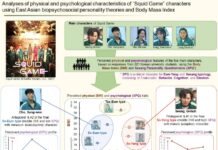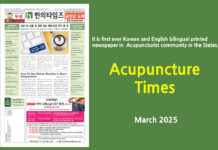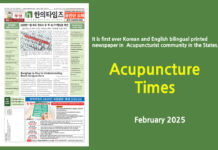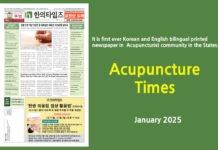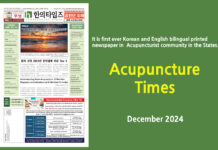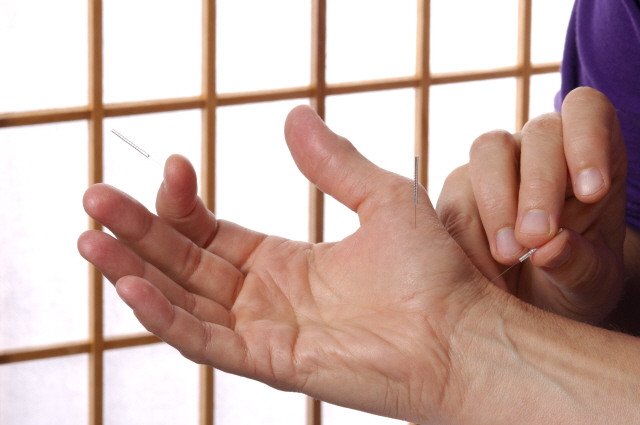- Hyo-Jung Kwon, Yong-Suk Kim*
Department of Acupuncture & Moxibustion, (Brain & Neurological Disorders and Pain), Kangnam Korean Hospital, Kyung Hee University, Seoul, Korea - Open Journal of Immunology, 2015, 5, 90-103
1. Introduction
Saam acupuncture is one of unique Korean acupuncture styles and its technique is widely adopted by clinicians and educational institutions in Korea today. It originated in the 17th century, probably by a Buddhist monk called “Saam”. Saam acupuncture provides basic acupuncture prescriptions for the imbalances of each of the twelve Meridians. The main energy traits of the 12 Meridians are employed by applying the promotion cycle (Sheng, creation, “nourishing”) and control cycle (Ke, governor, “suppressing”) relationships of the Five Elements (or “Five Phases”) theory onto the Five Shu points and 12 Meridians [3] [4]. Saam acupuncture summarizes diverse physiological or pathologic processes into 12 images of Qi imbalance corresponding to the 12 Meridians and expands the use of the Five Shu points. The manuscripts of Saam acupuncture carry clinical applications and modifications of the basic acupuncture prescriptions [5].
Five Elements acupuncture consists of tonification and sedation using Five Shu points. Five Elements acupuncture, also known as “tonification and sedation in self-Meridian” on the basis of the creation cycle, was first proposed by Gao-wu during the Ming dynasty in China. Saam developed this technique further by extending it into another Meridian and using the governor cycle in self- and other-Meridians. Gao-Wu, during the Ming Dynasty (1519 AD), was the first and foremost medical acupuncturist to tonify deficiency and sedate the excess on the basis of either depletion or repletion of the promotion cycle, which is explained in “The Four Needle method” by Ross [6] [7]. Saam acupuncture [8] proposes the Five Elements acupuncture style that simultaneously uses the Five Shu points of the promotion and the control cycles, called the “Four Needle technique” by Hicks et al. [9] and the “eight Needle methods” by Ross [6].
Gao-Wu described the use of “tonification and sedation points” along the self Meridian using the Five Shu points. The basis of Gao-Wu’s treatment was the creation (mother-child) cycle and is included in the “Four Needle method” with the following rules: to determine the tonification point for a Meridian, select the Mother Element on the Meridian in question, and to determine the sedation points, select the Child Element. But Saam acupuncture, on the basis of Gao-Wu’s treatment, created a Five Element acupuncture therapy by adding the control (grandmother-grandchild) cycle, as well as selecting acupuncture points among other related Meridians.
From the above approach, this theory consisted of two tonifications and two sedation points, which were selected from among the Five Shu points. The Five Shu points had characteristics of their particular Five Elements theory according to the difficult issues in Nan-Ching.
The principles of Saam acupuncture originated from the creation and controlled cycles among the Five Elements and had the following rules: to determine the tonification and sedation points for a Meridian in deficiencies, first tonified the mother Element Five Shu points on the Meridian in question as well as the master point (Five Shu points of same Element as the Meridian) on the mother Element Meridian, and then sedated the Controller Element Five Shu points on the affected Meridian as well as the master point on the Controller Element Meridian; to determine the tonification and sedation points for a Meridian in excesses, first sedated the child Element Five Shu points on the affected Meridian, and then tonified the Controller Element Five Shu points on the affected Meridian as well as the master point on the Controller Meridian.
There also exists another setting of tonification and sedation system called the “coldness-heat acupuncture treatment”, derived from the “deficiency-excesses acupuncture treatment”, that is simple and rarely used because it selects only the Water and Fire Element Five Shu points among a Meridian and has the following rules: for cold symptoms, to determine the tonification and sedation points for a Meridian, first tonify the Fire Element Five Shu points on the affected Meridian as well as the Fire point on the Fire Meridian—namely HT8 for Yin Meridians and SI5 for Yang Meridians, and then sedate the Water Element Five Shu points on the affected Meridian as well as the Water point on the Water Meridian—namely KI10 for Yin Meridians and BL66 for Yang Meridians.
For heat symptoms, to determine the tonification and sedation points for a Meridian, first sedate the Fire Element Five Shu points on the affected Meridian as well as the Fire point on the Fire Meridian, and secondly tonify the Water Element Five Shu points on the affected Meridian as well as the Water point on the Water Meridian.
1.1. Acupoints Used in Saam Acupuncture
The Five Shu points, located below the elbow and knee joints, could be used corresponding to the Five Elements for imbalances in correlation to tonification and sedation [10] (Table 1). Every acupuncture point has an effect on disturbances of the corresponding channel and the coupled channel as well as on the illness of the corresponding Organ, the allocated tissues and sensory Organs [11]. Acupuncture points have an effect on the related channel axis, for example, ST38 along the Yangming Meridian on the shoulder, more namely the Stomach Meridian and the Large Intestine Meridian.
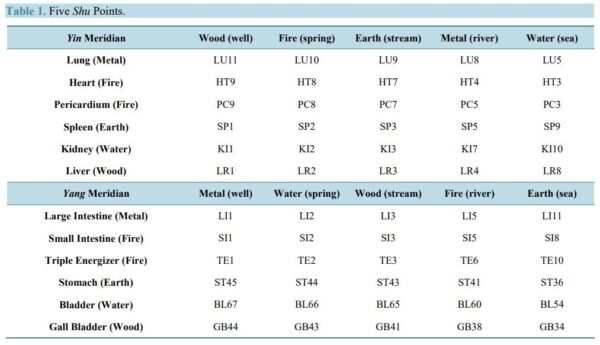 Giovanni [12]: “The sections of channel between fingers/toes and elbows/knees are more superficial than the rest, which is one of the reasons for the importance of the points lying along its path. The energetic action of the points along a section of such a channel is much more dynamic than other points, which explains their frequent use in clinical practice. Another reason for the dynamism of these points is that, at the tips of fingers and toes, the energy changes polarity from Yin to Yang or vice versa and, due to this polarity change, the Qi of the channel is more unstable and thus more easily influenced. The progression of the Five Element points along the channel is probably in relation to this change of polarity, as the second point belongs to the Fire in the Yin channels and the Water in the Yang channels. Five points situated along this channel section are particularly important and are called the Five Transporting points; they also coincide with what are called the Elements points. However, the dynamic of these points is irrespective of their Five Elements character”.
Giovanni [12]: “The sections of channel between fingers/toes and elbows/knees are more superficial than the rest, which is one of the reasons for the importance of the points lying along its path. The energetic action of the points along a section of such a channel is much more dynamic than other points, which explains their frequent use in clinical practice. Another reason for the dynamism of these points is that, at the tips of fingers and toes, the energy changes polarity from Yin to Yang or vice versa and, due to this polarity change, the Qi of the channel is more unstable and thus more easily influenced. The progression of the Five Element points along the channel is probably in relation to this change of polarity, as the second point belongs to the Fire in the Yin channels and the Water in the Yang channels. Five points situated along this channel section are particularly important and are called the Five Transporting points; they also coincide with what are called the Elements points. However, the dynamic of these points is irrespective of their Five Elements character”.
Yun-Tao-Ma [13]: “An interesting neurological fact is that the limbs below the elbows and knees occupy large regions in the brain sensory gyrus. Thus, the acupoints below the elbows and knees also occupy a large region in the cortical representation of the brain’s post-central sensory gyrus. This correlation may explain the reason why the acupoints below the elbows and knees contain more sensory receptors and needling stimulation of these points can induce a greater reaction and activity in the brain. This principle clearly supports the concept of using certain acupoints below the elbows and knees as diagnosis and treatment points during acupuncture treatment”.
Most illnesses are caused by interruptions of Qi and blood manifested by stagnation and irregularities. Illnesses are also caused by imbalances of Organs brought on by deficiency and excess through the Meridian network. Acupuncture treatments, therefore, must cover these two aspects of illness to achieve acupoint efficacy and functions of tonification and sedation. In order to gain greater efficacy, acupuncture based on acupoint efficacy and Saam acupuncture can be combined to simultaneously correct interruptions and imbalances as well as have tonification-sedation effects. In relations to the principles of acupuncture treatments, the acupuncture procedures based on acupoint efficacy to correct interruptions can be assumed as “branch treatment”, and acupuncture based on tonification-sedation effects to correct imbalances can be assumed as “root treatment”. Effective acupuncture treatment, therefore, is a combination of acupoint efficacy with Five Element acupuncture [2].
It can be said that a local acupoint directs the treatment strategy to the affected energetic functional sphere or zone (in internal energetic disturbances), while the distal acupoints serve to determine the nature of the energetic manipulation (such as tonification, dispersal, warming, cooling, harmonizing) [14]. The combination of local and distal acupoints forms a pattern of treatment that resembles the pattern of the disharmony being treated. In its most sophisticated application, a treatment pattern and its effects will confirm the diagnosis of the pattern of disharmony. In order to have more effective acupuncture treatment results for other diseases, combination methods that cover local, special and distal acupoints should be used to increase efficacy and serve as tonification or sedation for imbalances. More effective treatment when using Saam acupuncture could be achieved by using it as a root treatment to correct imbalances, while local acupoints, special acupoints and symptomatic treatments are applied as branch treatment to correct interruptions in proper stimulation techniques [4].
1.2. Promotion and Control Cycles Leading to the Disease Type of Five Evils
The 50th issue of Nan-Ching explains the pathology of the Five Evils [15] [16] and the 69th issue of Nan-Ching describes the treatment for these evils. This method consists of, in a broad sense, the method of “tonificationsedation between deficiency and excess” as well as the method of “tonification-sedation between coldness and heat”.
Among the illnesses are the Depletion, Repletion, Destroyer, Weakness, and Regular Evils, and distinguished as thus:
- 1) Those (illnesses) coming from behind represent a Depletion Evil;
- 2) Those coming from ahead represent a Repletion Evil;
- 3) Those coming from what cannot be overcome represent a Destroyer Evil;
- 4) Those coming from what can be overcome represent a Weakness Evil;
- 5) If the respective depot is afflicted from within itself, it represents a Regular Evil.
In case of depletion, it should be filled, while in case of repletion, it should be drained. When neither repletion nor depletion is present, the illness should be removed from the conduits, meaning that in the case of depletion, one should fill the respective (conduit’s) mother, and in case of repletion, one should drain the respective (conduit’s) child. One must fill first and then drain afterward (Table 2).
 One characteristic of Saam acupuncture is the addition of the control (governor) cycle—consisting of grandmother and grandchild elements—to the promotion cycle—consisting of mother and son elements. This method includes a new concept of the “governor Meridian” in the application of the law of the Five Elements based on the inter-destructive cycle.
One characteristic of Saam acupuncture is the addition of the control (governor) cycle—consisting of grandmother and grandchild elements—to the promotion cycle—consisting of mother and son elements. This method includes a new concept of the “governor Meridian” in the application of the law of the Five Elements based on the inter-destructive cycle.
Wang Sheng Xiu Qiu Si is another concept of the Five Elements [17]. Wang Sheng Xiu is a family and in a promotion cycle of the Five Elements, while Qiu Si is an enemy and in a control cycle of the Five Elements. In promoting the cycle of the Five Elements, a reinforcing method can be done while the control cycle of the Five Elements require a reducing method. It is meaningful that each Element promotes like a family in the promoting cycle while each Element reduces like an enemy.
Ross [6] calls acupoint selection of tonification and sedation among its own Meridians “Within Element treatments” and acupoint selection of tonification and sedation among other Meridians “Between Element treatments”. This selection, in what is called the Four Needle method, is based on the theory of promotion cycle of the Five Elements. He also explains the Eight Needle method which selects another acupoint based on the theory of the inhibition cycle of the Five Elements, in addition to the Four Needle method. He did not explain the originality of its treatments, but the selection is the same as Saam acupuncture.
1.3. The Six Energy Characteristics of Three Yin and Three Yang
To achieve a comprehensive understanding of the energy controlled by Meridians, both the Five Elements and Six Energy characteristics must be considered. The characteristic energy controlled by the Meridian is determined not only by the Five Elements, but also by the Six Energy attributes. Six Energies are the subdivision of Yin and Yang energies into three Yin and three Yang, namely Jueyin (“absolute Yin”), Shaoyin (“lesser Yin”), Taiyin (“greater Yin”), Shaoyang (“lesser Yang”), Yangming (“brilliant Yang”) and Taiyang (“greater Yang”). They correspond to Wind, King Fire, Earth, Premier Fire, Metal and Water traits respectively. These Six Energies are subdivided into 12 energies mainly controlled by 12 Meridians that function as energy combined with the Five Elements energy in Meridians located in either the upper or lower extremities. For example, although
both the Gall Bladder (GB) and Liver (LR) Meridian energies are Wood, GB energy is Shaoyang while LR energy is Jueyin from the Six Energy perspective. The LR Meridian energy is Jueyin combined with Wood, while the Pericardium (PC) Meridian energy is Jueyin combined with Fire (Premier Fire).
1.4. Five Elements
Most illness and disturbances are rooted in interruptions or imbalances in a network of Meridians. Interruptions comprise stagnation and irregularities, and imbalances are deficiency and excess [6]. A typical diagnosis in Saam acupuncture is one of four imbalances of a Meridian energy, which are deficiency, excess, cold or heat. A physician should first find out the Meridian in which the core imbalance of energy is located, and then determine which type the imbalance belongs to. For example, when the energy of Shaoyang, which is expressed as GB or Triple Energizer (TE) Meridian energy, is excessive it may be expressed as a dogmatic personality, sensitive mind or an inclination to give advice to others. When deficient, this energy may be expressed as an atrocious personality, cold mind or a sense of inferiority. More specifically, the energy of GB is associated with centering energy, bright light, aggressiveness, activeness, braveness, dignity or an arrogant attitude, and with energy often compared to a wind power plant or a thunderbolt [18].
The scope of Saam acupuncture can be extensive because of its diverse laws, such as the promotion and inhibition (control) cycle among the Five Elements and its connected Meridians. A Meridian consists of three parts, that is, arm or foot, the more or less of Yin and Yang, and one of Six Organs (Zang) and Six Bowels (Fu). When applying the theory of Yin-Yang and the Five Elements, the essence of what we are after is the energetic movements of disharmonies which are fleeting. The Eight Guiding Criteria make it possible to systematically analyze all data that are gathered in a consistent manner, and thus measure a patient’s pattern of disharmony against the major patterns of Chinese medical pathology [14].
References
[1] Yin, C., Park, H.J., Chae, Y., Ha, E., Park, H.K., Lee, H.S., et al. (2007) Korean Acupuncture: The Individualized and Practical Acupuncture. Neurological Research, 29, 10-15. http://dx.doi.org/10.1179/016164107X172301
[2] Kim, D.-H. and Kim, J.-H. (1993) The Literary Study on the Written Date of and the Background of Sa-Ahm’s 5 Element Acupuncture Method. Kyungwon University, Kyungki.
[3] Yin, C.-S. Chae, Y.-B., Koh, H.-G., Lee, H.-J., Chun, S.-I., et al. (2006) Constitutionally Individualized and Practically Integrated Characteristics of Korean Acupuncture. Korean Journal of Acupuncture, 23, 19-28.
[4] Ahn, C.B., Jang, K.J., Yoon, H.M., Kim, C.H., Min, Y.K., Song, C.H., et al. (2010) Sa-Ahm Five Element Acupuncture. Journal of Acupuncture and Meridian Studies, 3, 203-213. http://dx.doi.org/10.1016/S2005-2901(10)60037-4
[5] Lee, T.H. (1996) Essentials of Saam’s Acupuncture Theory. Haenglim Publishing, Seoul.
[6] Jeremy, R. (2004) Acupuncture Point Combination. Churchill Livingstone, Edinburgh.
[7] Wu, G. (1980) Gatherings from Eminent Acupuncturists-Zhen Jiu Ju Ying. Shinmunfung Publisher, Taipei.
[8] Heng-pa (1975) The Essence of Sa-Ahm’s Acupuncture. Heng-Lim Publisher, Seoul.
[9] Hicks, A.H.J. and Mole, P. (2005) Five Element Constitutional Acupuncture. Churchill Livingstone, Edinburgh, 383-384.
[10] Zhang, Y. (1977) Huang-Ti Nei-Ching Su-Men Ling-Shu Ji-Zhu He-Pian. Tai-Lian Guo-Feng Chu-Ban She, Taipei.
[11] Ahn, C.B., Jang, K.J., Yoon, H.M., Kim, C.H., Min, Y.K., Song, C.H., et al. (2009) A Study of the Sa-Ahm Five Element Acupuncture Theory. Journal of Acupuncture and Meridian Studies, 2, 309-320. http://dx.doi.org/10.1016/S2005-2901(09)60074-1
[12] Maciocia, G. (2005) The Foundation of Chinese Medicine. Churchill Livingstone, Edinburgh.
[13] Ma, Y. and Cho, Z. (2005) Biomedical Acupuncture for Pain Management. Churchill Livingstone, Edinburgh.
[14] Seem, M.D. (1991) Acupuncture Energetics. Healing Arts Press, Rochester.
[15] Chang, S. (1912) Chiao-cheng t’u-chu pa-shih-i Nan-Ching. Hung-pao chai shu-chu, Taipei, 6-11.
[16] Unschuld, P.U. (1986) Nan-Ching—The Classic of Difficult Issues. University of California Press, Oakland, 474-617.
[17] Lee, I. (2007) A Study on the Basic Forms and Principles of Saam’s 5 Phase of Acupuncture Method. Journal of the Korean Acupuncture and Moxibustion Society, 1, 19-51.
[18] Kim, H.G. (1992) Handbook of Saam Acupuncture. Shinnongbaekcho Press, Seoul.



